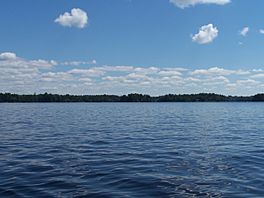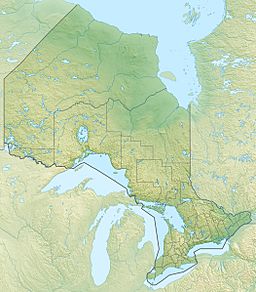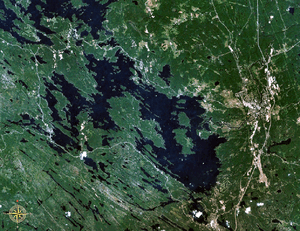Lake Muskoka facts for kids
Quick facts for kids Lake Muskoka |
|
|---|---|
 |
|
| Location | Ontario |
| Coordinates | 45°02′N 79°27′W / 45.033°N 79.450°W |
| Primary inflows | Muskoka River, Indian River |
| Primary outflows | Moon River |
| Basin countries | Canada |
| Surface area | 120 km2 (46 sq mi) |
| Surface elevation | 225 m (738 ft) |
| Settlements | Muskoka Lakes, Gravenhurst, Bala |
Lake Muskoka is a beautiful lake in Ontario, Canada. It's a popular spot for cottages and summer fun! You'll find it nestled between towns like Port Carling and Gravenhurst, Ontario. The lake is a big part of the Township of Muskoka Lakes. The town of Bala is on its southwest shores.
Lake Muskoka is connected to Lake Rosseau by the Indian River. They also share a lock system at Port Carling. The lake gets most of its water from the Muskoka River, Lake Joseph, and Lake Rosseau.
Contents
Discovering Lake Muskoka's Past
First Peoples of Muskoka
The first records of Muskoka date back to 1615. At that time, Algonquin and Huron tribes lived here. Early European explorers like Samuel de Champlain visited the area. Missionaries followed them later.
The name Muskoka comes from an Ojibwe or Chippewa chief. His name was Musquakie. It means "not easily turned back in the day of battle." He was also known as Chief Yellowhead. He signed treaties that sold about 250,000 acres (1,010 km2) of land to the Province of Canada. The government respected him so much that they built him a home. He lived there until he was 95 years old.
The land in Muskoka has many lakes and rocks. This made it great for fishing, hunting, and trapping. But it was not good for farming. The Ojibwa people used Muskoka as their hunting grounds. Another Ojibwa tribe lived near Port Carling. They called it Obajewanung. This tribe moved to Parry Sound around 1866.
Europeans Arrive in Muskoka
Europeans didn't settle much in Muskoka until the late 1760s. They mostly came for seasonal fur trapping. After the American Revolution, the government worried about invasion. They looked for travel routes between Lake Ontario and Georgian Bay. In 1826, Lieutenant Henry Briscoe was the first known white person to cross central Muskoka. David Thompson drew the first maps of the area in 1837.
Many Europeans moved to Canada in the mid-1800s. Many came from Ireland due to a famine. The government wanted to open Muskoka for settlement. Logging licenses were given out in 1866. This started the logging industry in Monck Township. The lumber industry grew fast. It cleared huge parts of the area. But it also led to new roads and water travel. The railroad reached Gravenhurst in 1875. It got to Bracebridge in 1885.
The Muskoka Colonization Road was started in 1858. It reached Bracebridge in 1861. This road was rough. Logs were placed across it to stop carriages from sinking. This made travel very bumpy. The lumber industry also led to new towns. Bracebridge, for example, had leather tanning businesses. They used tree bark from logging to tan animal hides.
The Free Grants and Homestead Act of 1868 opened Muskoka for many settlers. People could get free land. They had to clear at least 15 acres (61,000 m2) for farming. They also had to build a 16 by 20-foot (6.1 m) house. But settlers found it very hard. Clearing dense forests was a huge job. Then they found many rocks that also needed to be cleared. The soil was mostly dense clay. It was not good for farming.
News of these tough conditions spread. It looked like Muskoka's growth might stop. But then something good happened. Back then, steamships were the best way to travel. Once a connection was made to the southern part of the lake in Gravenhurst, logging companies could easily move trees. They could harvest trees along the whole lakefront.
The Steamship Era
Alexander Cockburn, known as the "Father of Muskoka," brought steamships to the lake. He started with the Wenonah in 1866. Its name means "first daughter" in Ojibwa. Cockburn pushed the government to open the whole Muskoka lake system for boats. This meant building locks in Port Carling. The government built the locks in 1871. Now Cockburn's steamers could reach all the lakes. He added more ships over the years. When he died in 1905, his Muskoka Navigation Company was the biggest in Canada. The RMS Segwun, built in 1887, still operates today!
In 1860, John Campbell and James Bain Jr. became some of the first tourists. They traveled by train and steamer to Orillia. Then they walked to Gravenhurst for their vacation. They loved it and came back every year. They brought friends and family too. These early tourists wanted more travel services. They loved the great fishing, natural beauty, and clean air.
Early tourists built simple camps. But soon, others wanted better places to stay. Farmers, who struggled with the rocky soil, found a new way to earn money. They offered rooms for overnight stays. This led to the first boarding houses and hotels. The first wilderness hotel, Rosseau House, was built in 1870. It was at the head of Lake Rosseau. This idea became popular. Tourism became a big money-maker in the 1880s.
The steamship era brought famous hotels to the area. These included Rosseau, Royal Muskoka, Windermere, and Beaumaris. The area grew fast when the railroad reached Gravenhurst in 1875. Travel from Toronto, Pittsburgh, and New York became easier. Trains took travelers to Gravenhurst. From there, they boarded large steamers like the Sagamo. These ships made regular stops around the lakes. Tourists often stayed for weeks or months in the summer.
As families visited often, they started building cottages near the hotels. At first, these were simple. Later, they became grander, some even having staff. Cottagers first used rowboats and canoes for daily travel. Eventually, steam and gasoline boats became popular. People used motors more than muscle power. With the boats came boathouses. These were often fancy buildings that looked like the main cottage.
The Arrival of Cars
World War I caused tourism to drop in Muskoka. This hurt the local economy. But new inventions like the motorboat and the automobile helped the area grow. Better roads were built. Vacationers no longer needed steamships to reach the lake. They built cottages farther away. This caused demand for steamships to fall.
World War II caused another decline. Many Americans stayed home. Many Canadians were busy with war efforts. After the war, prosperity brought another boom. This was thanks to cars and new, affordable fiberglass boats. Owning a summer cottage became possible for many middle-class families. This led to more development around the lake. The steamship companies stopped their services one by one. The last one sailed in the late 1950s.
Aircraft Incidents on Lake Muskoka
During World War II, a Northrop Nomad A-17A plane crashed into Lake Muskoka. This happened on December 13, 1940. Two pilots, Peter Campbell and Ted Bates, were involved. They were searching for another missing pilot. Their plane collided with another Nomad over the lake. Both planes went into the icy water. The other plane was recovered in 1941.
Between 1942 and 1945, the Royal Norwegian Air Force (RNAF) trained pilots. This happened at the Muskoka Airport, known as "Little Norway". One training plane crashed off Norway Point. The pilot did not survive. The aircraft was accidentally found by a cable crew in 1960. The pilot was still inside. For unknown reasons, the plane was cut free. It fell back to the bottom with the pilot. Authorities are looking into this site.
Another training plane, a Fairchild PT-19 Cornell, crashed in August 1944. Its wing broke off. Both the pilot and student did not survive. Not long after, another Fairchild crashed for the same reason. But this time, both people escaped using parachutes.
Community Groups Protecting Lake Muskoka
Many community groups work to protect Lake Muskoka. The largest of these is the Muskoka Lakes Association (MLA).
Muskoka Lakes Association: Protecting Our Lakes
The Muskoka Lakes Association (MLA) is a group that works to keep the Muskoka area healthy. They want to protect it for future generations of cottagers. Lake Muskoka is a very important place for many people with cottages. The MLA was formed in 1894. This means it has been working for over 120 years! The MLA also focuses on Lake Muskoka's "sister lakes," Lake Joseph and Lake Rosseau. The MLA represents thousands of people in the Muskoka area. This includes both local residents and seasonal visitors.
One main goal of the MLA is to improve the lake's quality. They started the Water Quality Initiative in 2000. But they began testing water way back in 1972. In 2013, over 100 volunteers collected water samples. These samples help them check for bacteria. They also measure things like dissolved organic carbon, phosphorus, and temperature. In 2013, the MLA collected over 1100 water samples. They focus on 18 key areas around Lake Muskoka.
Besides water quality, the MLA also helps the environment in other ways. They hold seminars with partners like the Muskoka Conservancy. These events teach shoreline owners how to protect the lakes and rivers. They also encourage keeping natural habitats along the water's edge. The MLA also has an annual Seedling Day. Waterfront residents can order native plants. These plants help stop erosion along the shoreline.
Historically, the MLA has always focused on water issues. Almost 100 years ago, they campaigned for boats to have working lights. Safe and respectful boating is still a big concern for the MLA. They work with BOATsmart! to help boaters get proper training. MLA members can even get discounts on boating courses. The MLA is also a founding partner of Safe and Quiet Lakes. This group promotes safe and respectful boating practices.





